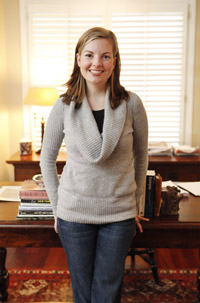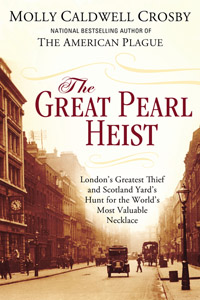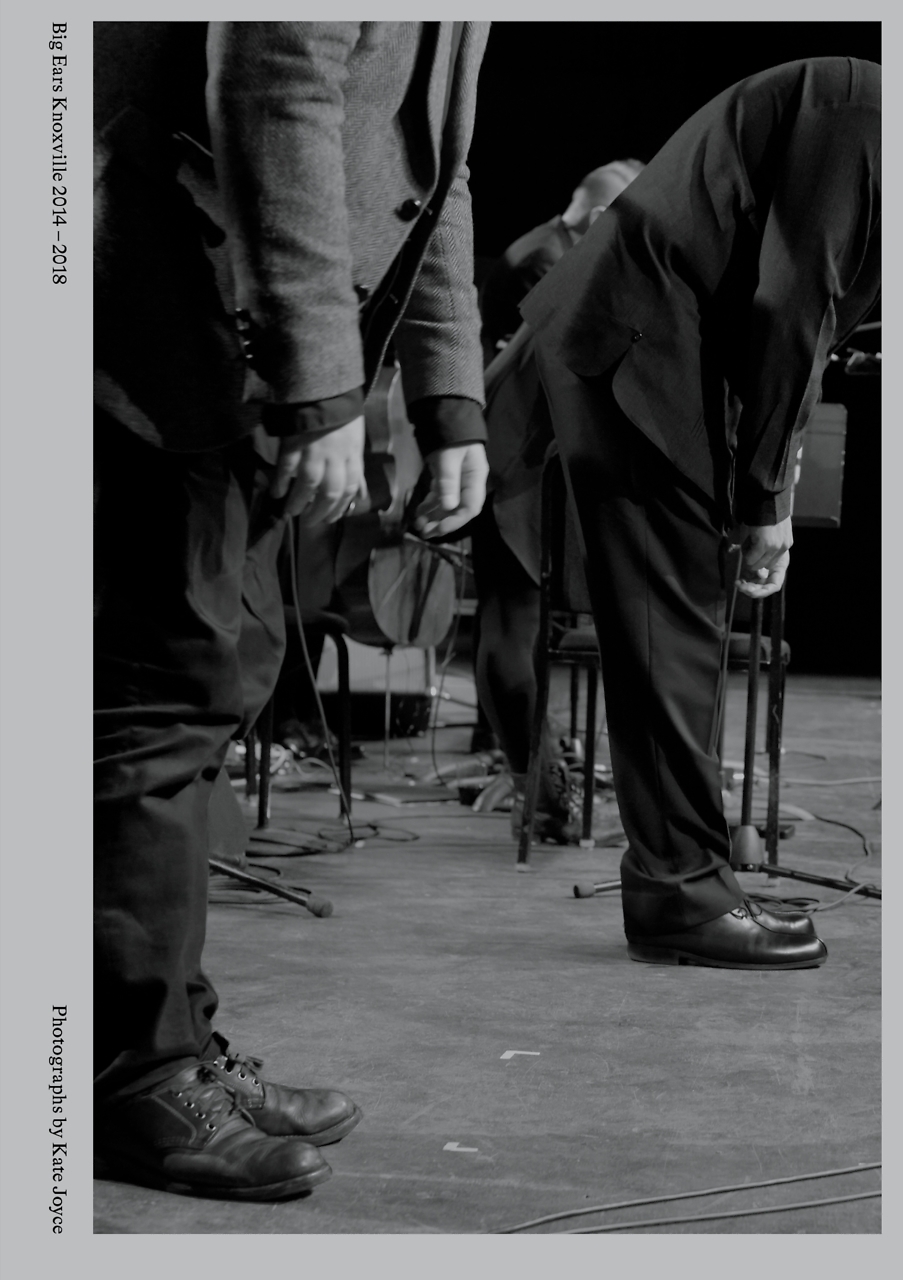A Captivating Caper
Memphis-based journalist and bestselling author Molly Caldwell Crosby investigates a fascinating tale of cops and robbers in Edwardian England
A good heist story needs three things: a clever and daring thief, a determined cop, and a supremely valuable object. It doesn’t hurt if the story is set in some exotic locale, complete with a menacing underworld and glittering socialite balls. It’s unusual for an author to pull all of these elements together not in a crime novel, but in a carefully researched work of historical nonfiction. Yet Memphis based journalist Molly Caldwell Crosby, author of two science-based works of historical nonfiction, The American Plague and Asleep, does exactly that in The Great Pearl Heist: London’s Greatest Thief and Scotland Yard’s Hunt for the World’s Most valuable Necklace.
 The thief: Joseph Grizzard, the “greatest receiver, fence, and putter-up of his time,” a criminal mastermind who seldom dirtied his own hands. Instead, he ran a smooth conspiracy from his fashionable home, one that caused Scotland Yard detectives to call him “the real-life Moriarty,” after Conan Doyle’s famous villain.
The thief: Joseph Grizzard, the “greatest receiver, fence, and putter-up of his time,” a criminal mastermind who seldom dirtied his own hands. Instead, he ran a smooth conspiracy from his fashionable home, one that caused Scotland Yard detectives to call him “the real-life Moriarty,” after Conan Doyle’s famous villain.
The cop: Alfred Ward, chief inspector of Scotland Yard, leader of a team of detectives who employed disguises, undercover operations, and carefully orchestrated stings—a new kind of police work for a new century—in their efforts to pursue the “uncatchable” Grizzard. Like his nemesis, Ward was self-educated: he was born in a London slum in the 1860s and worked his way into a more “respectable” life, eventually surrounding himself with cultivated, talented friends and colleagues who helped him reach the pinnacle of his profession.
The prize: a strand of sixty-one flawless pearls, graduated in size, slightly pink in color, insured by Lloyds of London for £135,000, or about $700,000 U.S. at the exchange rate of the period. Crosby calculates the necklace’s value in purchasing power as about $18 million in today’s currency; as a percentage of GDP, about $121 million. By any measure, it was the single most valuable piece of jewelry that had ever been stolen, worth even more than the Hope Diamond that would be famously snatched decades later by Murph the Surf.
The setting: London, 1913. From the Dickensian horrors of the East End through the crowded jewel market at Tenterhooks to the dusty halls of the Old Bailey, Crosby paints a city “scudding ahead of a world war on the horizon.” Straddling the Victorian and the modern, its filthy streets bustled with motorcars and donkey carts; its lurid headlines proclaimed news of murder, theft, determined suffragettes, and a distant Balkan war. The city provides more than a perfect backdrop for a daring crime: as portrayed by Crosby, it becomes the perfect accomplice.
Best known as a science writer for her previous books, as well as her work for Health, Newsweek, and National Geographic magazines, Crosby brings a clinical eye to her subject, creating a narrative that manages to remain both exciting and informative. While there is plenty of nefarious action in this book, there is also carefully researched detail and well reasoned sociological analysis. One of the more gifted members of the Grizzard gang, for example, was Blonde Alice Smith—a women who looked so ordinary that she could quickly blend in with a crowd of observers, her hidden pockets loaded with loot. In describing Smith, Crosby notes, “Thievery proved very egalitarian. Women thieves could work alongside or even lead men in a time when that happened nowhere else in society. The Forty Thieves gang of women exemplified that business model. They operated succinctly and lucratively for as many as two hundred years—one of the longest running, most successful gangs in history.”
 Grizzard’s previous targets included diamond necklaces and even the massive Ascot gold trophy, stolen from under the noses of royal guards on Derby Day. One thing his heists shared was a cultivated information network. Members of Grizzard’s gang befriended and bribed postmen, guards, maids, menservants, drivers, and anyone else who could be convinced by a few pounds—or pints—into sharing small bits of information that, when pieced together, would create a detailed map of the vulnerability of valuable objects.
Grizzard’s previous targets included diamond necklaces and even the massive Ascot gold trophy, stolen from under the noses of royal guards on Derby Day. One thing his heists shared was a cultivated information network. Members of Grizzard’s gang befriended and bribed postmen, guards, maids, menservants, drivers, and anyone else who could be convinced by a few pounds—or pints—into sharing small bits of information that, when pieced together, would create a detailed map of the vulnerability of valuable objects.
Such was the case with a fabulous pearl necklace acquired by a London dealer named Max Mayer and shipped to Paris to be shown to a wealthy client. Grizzard quickly learned everything that was knowable about Mayer, about his partner in Paris, and about the necklace itself, which was so extraordinary as to be slated for a public tour of European cities—which meant it would have to be moved many times, and each movement created an opportunity.
As Crosby provides the cunning details of the theft Grizzard arranges, a plan both complicated and simple, the reader can almost hear Scott Joplin ragtime playing in the background. Unfortunately for Grizzard, stealing such a valuable object was bound to be easier than unloading it: by 1913, he was such a well-known criminal that he remained under constant police surveillance, and the necklace was such a unique prize that the moment it vanished, Grizzard would become Scotland’s Yard prime—and perhaps only—suspect.
Thus the second half of the book becomes an elaborate dance between the well-matched thief and detective, each of whom Crosby portrays as developing a growing admiration for the other’s cleverness. As with all complex enterprises, chance and coincidence play as important a role as cunning, which leads, as readers might suspect in any heist story, to a climactic trial in the Old Bailey, prosecuted by one of England’s “greatest legal minds,” Sir Richard Muir. In a story that is ultimately satisfying, readers are left not with right and wrong, with hero and villain—but with two unforgettable heroes, one a detective, the other a thief.
What is perhaps most amazing about Crosby’s memorable portrayal of character and crime in The Great Pearl Heist is her commitment to historical accuracy. As she remarks in her extensive notes at the back of the book, “Even though the dialogue often sounds like it came straight from a Sherlock Holmes story or a detective film, it’s all true.”
Molly Caldwell Crosby will discuss The Great Pearl Heist at The Booksellers at Laurelwood in Memphis on December 4 at 6 p.m.


